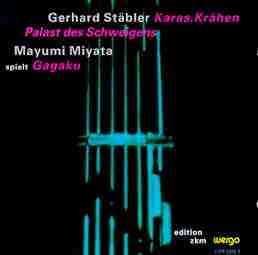
Program:
Karas. Krähen
Gagaku
Palatst des Schweigens
(all compositions by Gerhard Stäbler)
total time: 63:00
released: 1998
review date: October 1999
label: Wergo, a division of Schott Music & Media.
Mainz, Germany
Edition zkm
Review by Steve Mobia
The Japanese mouth organ called a "sho" is a direct predecessor to the accordion. Over 3,000 years old, it consists of 17 bamboo pipes of different lengths joined by a bowl shaped wind chamber. The player holds the instrument in front of their face and plays by blowing into it while opening and closing holes. Metal tongues vibrate to create the sound. It has traditionally been used in Japanese court music along with flutes, zithers and lutes. The music accompanied religious festivals as well as official state affairs and banquets.
The sound of the sho is not unlike the accordion, though it has a thinner delicate quality and lacks any bass resonance. The pitches can sound on both inhaling and exhaling and so can produce extended tones as can the accordion (reversing the breath similar in effect to reversing the bellows).
The music on the album was written by contemporary composer Gerhard Stäbler and though inspired by trips to Japan is decidedly not traditional court music. My only previous exposure to Stäbler's music was on a CD of solo accordion music performed by Teodoro Anzellotti. I had a mixed reaction to that as I have to the music on this album.
The first piece Karas. Krähen is an amazing and thoroughly engrossing tone poem consisting of percussion, sho, voice, contrabass, electronics and altered recordings of ravens, radio and street sounds. The composer explains in the liner notes that while staying in Japan he was haunted at night by the cries of ravens. The birds have a complex and contradictory mythology built up around them often linking to fate and misfortune as well as to the life giving sun. In Karas. Krähen, the raven's calls often come at crescendos of ominous density.
More often the music is hypnotic, extended. The live instruments, particularly the sho, are seamlessly integrated into the strange soft metallic sounds that form the consistent fabric of this work. Much of the sound though apparently acoustic in origin is mysterious and mesmerizing. Headphones are a must for this experience.
The piece is in three sections. After the raven's announcement amid a metallic buzzing hive, we hear a man's low chant blending with bass tremolos. The sho enters playing a duet with a mysterious high overtone. Suddenly a timpani roll and gong bring back the ravens and the textures get momentarily more insistent and dense. Soon they taper off to faint meditative traces.
The second section introduces sharp staccato metallic bursts leading to what appears to be irregular breathing. This later is transformed into something resembling a hand wood saw. Odd pops dominate the foreground (at first I thought the CD was damaged). The saw resumes to conclude this part.
A woman's voice now accompanies the sho, and a yawning scream brings in the high chirping of cicadas. Ravens' calls are now transformed into metallic ring modulated waves. Muffled radio signals and high voltage lines lead to a quiet continuance of the initial sho theme. Finally only soft high pitch ringing leads into the distance.
After the adventure of Karas. Krähen, the rest of the album proves disappointing to me. The sho as a solo instrument playing Stabler's drawn out rhythmless chords does not sustain concentrated listening. As an ambient recording however it sometimes succeeds particularly in Gagaku where the two sections winter and spring are practically indistinguishable.
There is more contrast in Palace of Silence. Very dramatic chords and rhythms include the performer, Mayumi Miyata, singing into the instrument while playing. The sho's dynamic and harmonic possibilities are pushed to the limit here. Soon though the music settles into a very long ambient meditative passage with simple and complex chords emerging and sinking back into silence. Eventually, sharply accented chords and single notes conclude. This piece is one of a series of studies for Stabler's opera Cassandra.
The accompanying booklet is well written and illustrated. Again, the first 23 minute track is astounding. The rest serves as an example of the sho's distinctive timbre but is not exciting music.
| About The Free-Reed Review |
| Invitation to Contributors / Submission Guidelines |
| Back to The Free-Reed Review Contents
Page |
| Back
to The Classical Free-Reed, Inc. Home Page |